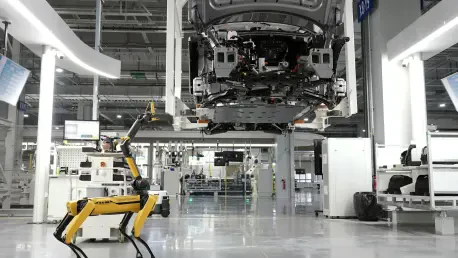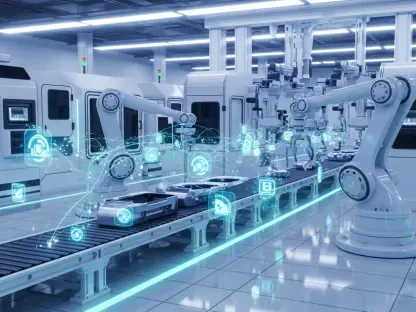In an era where technology is reshaping every facet of daily life, the semiconductor industry stands as a cornerstone of innovation, powering advancements that seemed like science fiction just a decade ago. U.S.-based chipmakers such as GlobalFoundries, Onsemi, and Diodes are at the forefront of this transformation, addressing the skyrocketing demand for sophisticated chips in both artificial intelligence and automotive applications. As AI moves beyond digital realms into physical, real-world interactions and vehicles become increasingly dependent on cutting-edge electronics, these companies are not just keeping pace but actively shaping the future. Their efforts are pivotal in enabling robotics that interact with the physical environment and cars that drive themselves with minimal human input. This article delves into the strategies and innovations these semiconductor giants are employing to fuel growth in physical AI and the automotive sector, while also tackling the geopolitical challenges that threaten to disrupt their progress.
Pioneering the Physical AI Revolution
The emergence of physical AI, which focuses on real-world applications like robotics, marks a significant shift in the technological landscape, and semiconductor companies are rising to meet this new demand with fervor. Unlike the generative AI models that have dominated recent headlines with their data center prowess, physical AI requires chips that balance high performance with low power consumption and cost efficiency to function in tangible settings. GlobalFoundries has articulated a bold vision for this space, estimating an addressable market surpassing $18 billion by 2030. This projection underscores a broader industry realization that the current focus on digital infrastructure is merely a stepping stone to more practical, everyday innovations. Chipmakers are now channeling resources into creating components that can withstand the rigors of real-world use, ensuring that devices like autonomous robots can operate reliably outside controlled environments, thus paving the way for a future where AI is seamlessly integrated into physical spaces.
Beyond the initial excitement surrounding data center expansions, there is a growing consensus among industry leaders that physical AI holds the key to transforming human interaction with technology on a fundamental level. Significant investments are being funneled into the development of secure, energy-efficient chips specifically designed for applications in robotics and other physical systems. This strategic pivot is not just about meeting current needs but anticipating a world where machines perform complex tasks in unpredictable settings. By focusing on specialized semiconductor solutions, companies are positioning themselves as indispensable players in a tech revolution that promises to redefine industries ranging from manufacturing to healthcare. The emphasis on creating chips that prioritize safety and efficiency reflects a deep understanding of the unique challenges posed by physical AI, ensuring that these technologies can be adopted widely without compromising reliability or affordability in diverse operational contexts.
Fueling Innovation in the Automotive Sector
The automotive industry has become a vital arena for semiconductor growth, driven by the rapid integration of advanced software and autonomous driving technologies into modern vehicles. Companies like Onsemi have reported substantial gains, with automotive revenue climbing to $787 million in a recent quarter, highlighting the sector’s critical role in their financial health. Similarly, GlobalFoundries has noted that automotive applications constitute a significant portion of its wafer revenue, with projections to reach multibillion-dollar figures by 2030. This surge reflects a broader trend where vehicles are no longer just modes of transport but complex technological platforms reliant on cutting-edge chips. The demand for semiconductors in this space is fueled by the need for everything from enhanced safety features to fully autonomous navigation systems, positioning chipmakers as essential partners in redefining transportation for the modern age.
As vehicles evolve into sophisticated hubs of technology, the role of chipmakers as enablers of innovation becomes increasingly pronounced, shaping the future of mobility with each new advancement. Despite facing short-term obstacles such as inventory adjustments, as acknowledged by Diodes, the overarching sentiment within the industry remains one of optimism regarding sustained growth in the automotive market. The ability to supply specialized, high-performance chips tailored for applications like infotainment systems and self-driving capabilities is crucial in meeting the expectations of manufacturers and consumers alike. This focus on delivering reliable and efficient semiconductor solutions ensures that the automotive sector can continue its trajectory toward smarter, safer, and more connected vehicles. The ongoing collaboration between chipmakers and automotive companies is fostering an ecosystem where technological breakthroughs are not just possible but expected, driving progress at an unprecedented pace across global markets.
Tackling Geopolitical and Trade Hurdles
Geopolitical tensions and trade policies, particularly tariffs, are casting a shadow over the semiconductor industry, compelling companies to rethink their operational strategies in a volatile global environment. Firms like Diodes are actively pursuing manufacturing flexibility to minimize the impact of tariffs, adapting their production footprints to navigate these economic pressures effectively. Meanwhile, GlobalFoundries is capitalizing on the trend of reshoring, forging partnerships to bring technological capabilities back to American soil, as demonstrated by its operations in Malta, New York. These varied approaches highlight a broader industry movement toward mitigating risks associated with international trade disruptions. By addressing these challenges head-on, chipmakers are not only protecting their bottom lines but also ensuring that the supply of critical components for physical AI and automotive applications remains uninterrupted amidst global uncertainties.
Operational agility has emerged as a defining trait for semiconductor companies striving to maintain stability in the face of external pressures like trade disputes and geopolitical shifts. Whether through diversifying manufacturing locations or bolstering domestic production capacities, these firms are taking decisive steps to safeguard their supply chains against potential disruptions. This adaptability serves a dual purpose: it reduces vulnerability to sudden policy changes while reinforcing their role as key contributors to the technological ecosystem that underpins physical AI and automotive advancements. Such strategic maneuvers are essential in an era where global dynamics can shift rapidly, affecting everything from component costs to market access. By prioritizing resilience, chipmakers are ensuring that their innovations continue to reach end-users, supporting the seamless integration of cutting-edge technologies into everyday life despite the complexities of the international landscape.
Shaping the Future Through Strategic Innovation
Reflecting on the strides made by semiconductor giants, it’s evident that their contributions to physical AI and automotive sectors are marked by both bold innovation and calculated responses to global challenges. Companies like GlobalFoundries, Onsemi, and Diodes have demonstrated remarkable foresight by investing in chips tailored for real-world AI applications and advanced vehicle systems, setting new benchmarks for what technology can achieve. Their ability to adapt to geopolitical pressures through reshoring and manufacturing flexibility has proven crucial in maintaining momentum during uncertain times. Looking ahead, the industry must continue to prioritize research into energy-efficient, secure semiconductors to support the next wave of technological integration. Collaboration with policymakers to address trade barriers and investment in domestic capabilities will also be vital. These steps will ensure that the foundation laid by these chipmakers evolves into a robust framework for future growth, driving societal and industrial progress on a global scale.









